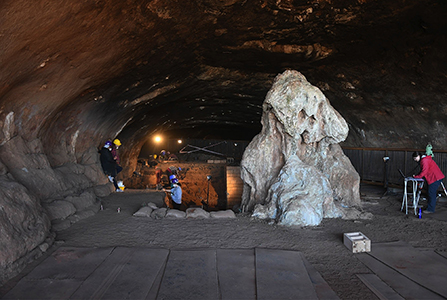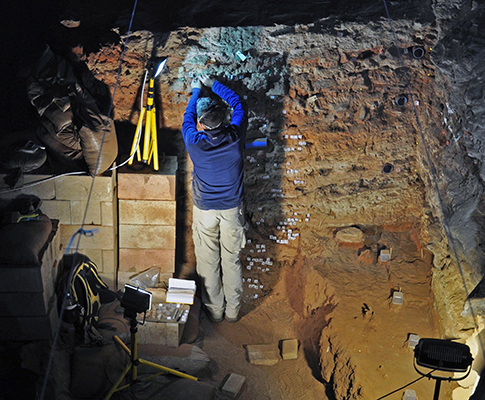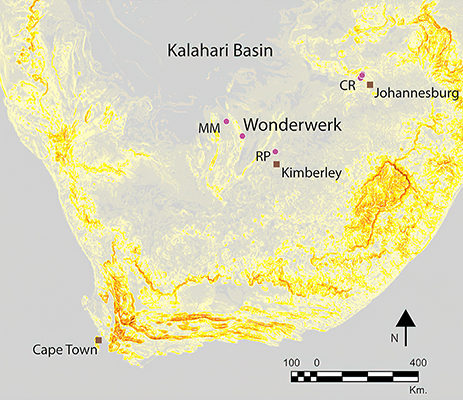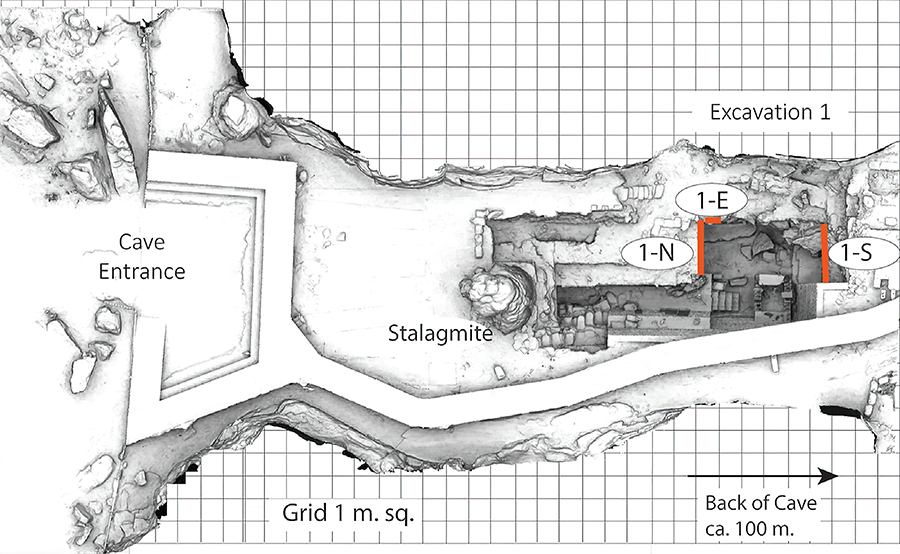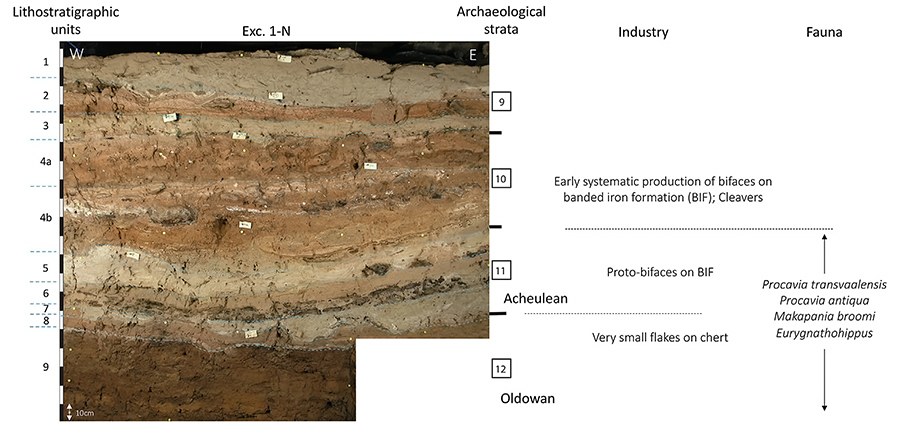Back to Don's Maps
 Back to Archaeological Sites
Back to Archaeological Sites
 Back to the review of hominins
Back to the review of hominins
Wonderwerk Cave - stone tools made by Homo habilis
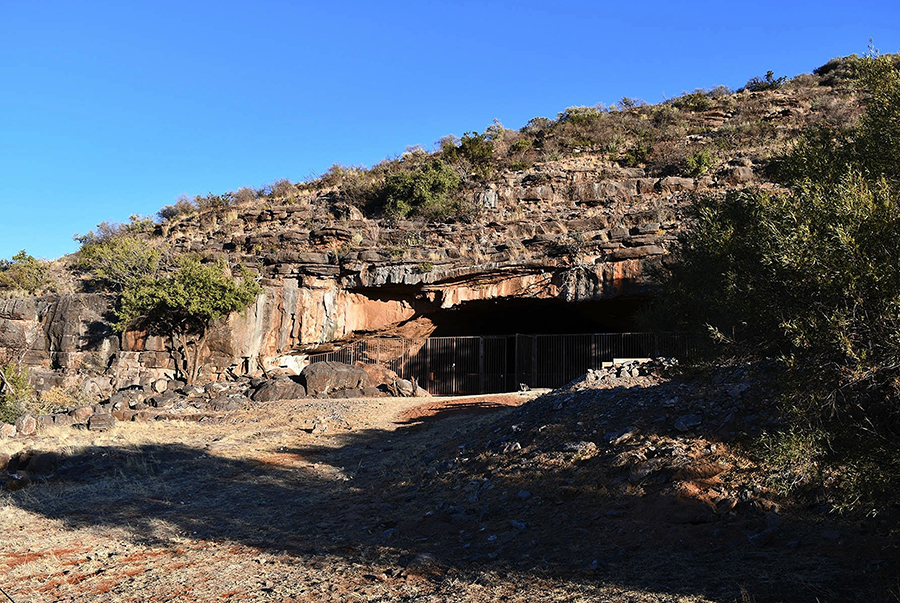
Wonderwerk Cave Entrance
Photo: Michael Chazan
Source: https://drive.google.com/drive/folders/103a60qIZCOi9zzRFUUzP376ZG4KHWvP_
Wonderwerk Cave in South Africa contains stone tools dated to two million years ago, possibly knapped by Homo habilis.
It lies about 43km north of Daniëlskuil on the road to Kuruman, and is about 43 km south of Kuruman, on the farm "Wonderwerk", which means 'miracle'.
Permanent water sources in the area are presently limited to a seep some 5 km to the south on Gakorosa Hill and a large sinkhole now known as Boesmans Gat (meaning 'Bushman's waterhole'), about 12 km away.
History of the cave from http://www.showcaves.com/english/za/showcaves/Wonderwerk.html :
- 05 July 1844 - first description of the cave by H. Methuen. The first white farmer at Wonderwerk, P. Bosman lived in the cave with his family and afterwards used it as a cart-house and sheep shelter.
- 1940-1944 - Commercial exploitation of the site for bat guano by N.J. Bosman.
- 1940-1948 - Archaeological investigations by B.D. Malan.
- 1974-1977 - Excavations by K.W. Butzer.
- 1979 - Excavations by J.F. & A.I. Thackeray.
- 1978-2002 - Excavations by P.B. Beaumont.
- 1993 - Cave and surrounding land ceded to the McGregor Museum by the Bosman and Nieuwoudt families.
Archaeological research at this massive cave site has revealed an immensely long record of human and environmental history spanning hundreds of thousands of years. The cave and its surroundings, form a conservation area with several features distinctive of the Kuruman Hills. The site is open to the public and includes an interpretative centre adjacent to the cave.Text above from: http://www.places.co.za/html/wonderwerk_cave.html
The site runs horizontally for 193 metres into the base of a low conical foothill on the eastern flank of the Kuruman Hills. It is a very ancient solution cavity, exposed at its northern end by hillside erosion, in stratified dolomitic limestone belonging to the 2.3 billion year old Ghaap Plateau Dolomite Formation.
Excavation teams from the McGregor Museum in Kimberley have revealed numerous fascinating artefacts. like stone impliments and engravings, decorated ostrich eggshells, Bushman hair, pollen dating back about 400 000 years, various animal bones and the 8 000 year-old teeth of a now extinct species of horse. Visitors can marvel at the Bushman paintings in mixed media - plant roots and blood.
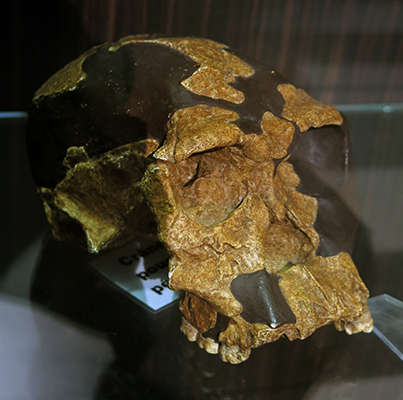
Homo habilis
OH 24
~ 1.8 million years old, Tanzania.
Facsimile
Photo: Don Hitchcock 2014
Source: Display, Paléosite at Saint Césaire.
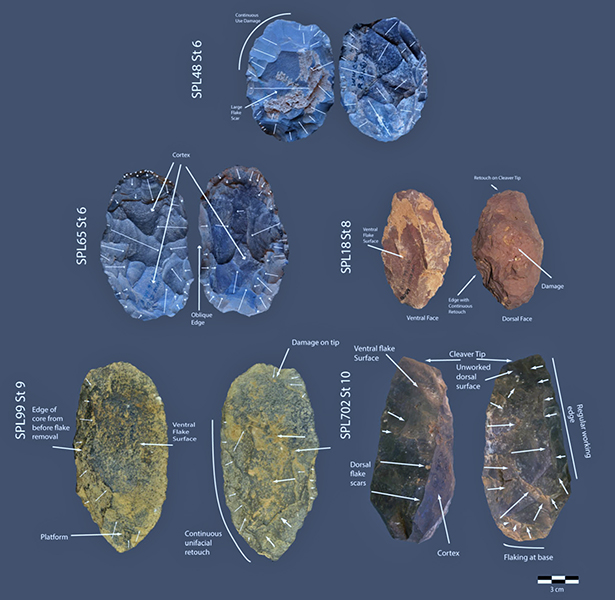
Acheulean cleavers from Wonderwerk Cave, Excavation 1.
Source: Chazan (2015)

Acheulean handaxes from Wonderwerk Cave, Excavation 1.
Source: Chazan (2015)
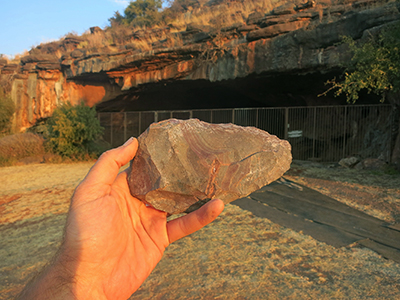
A handaxe from the Acheulian layers at Wonderwerk. In the background is the cave entrance.
Photo and text: Michael Chazan and the Wonderwerk Excavation Teams
Source: https://drive.google.com/drive/folders/103a60qIZCOi9zzRFUUzP376ZG4KHWvP_
Text below adapted from phys.org (2021)
Few archaeological sites have a continuous archaeological record spanning millions of years. Wonderwerk Cave, in the Kalahari Desert of South Africa, is one of those sites. It is one of the earliest cave occupation sites in the world, and is the site of some of the earliest uses of controlled fire and tool making.
Professor Ron Shaar of the Hebrew University's Institute of Earth Sciences notes that 'We can now say with confidence that our human ancestors were making simple Oldowan stone tools inside the Wonderwerk Cave 1.8 million years ago. Wonderwerk is unique among ancient Oldowan sites, a tool-type first found 2.6 million years ago in East Africa, precisely because it is a cave and not an open-air occurrence.'
Excavation site in Wonderwerk Cave.
Photo: Michael Chazan
Source: https://drive.google.com/drive/folders/103a60qIZCOi9zzRFUUzP376ZG4KHWvP_
The team were able to successfully establish the shift from Oldowan tools (mainly sharp flakes and chopping tools) to early handaxes over 1 million years ago, and to date the deliberate use of fire by our prehistoric ancestors to 1 million years ago, in a layer deep inside the cave. The latter is a particularly significant because other examples of early fire use come from open-air sites where the possible role of wildfires cannot be excluded. Moreover, Wonderwerk contained a full array of fire remnants: burnt bone, sediment and tools as well as the presence of ash.
Dating cave deposits is one of the greatest challenges in palaeoanthropology, the study of human evolution. To overcome this challenge, the team analysed a 2.5 metre thick sedimentary layer that contained stone tools, animal remains and fire remnants using two methods: palaeomagnetism and burial dating. 'We carefully removed hundreds of tiny sediment samples from the cave walls and measured their magnetic signal' said Shaar. Magnetization occurred when clay particles, that entered the cave from outside, settled on the prehistoric cave floor, thereby preserving the direction of the earth's magnetic field at that time. 'Our lab analysis showed that some of the samples were magnetised to the south instead of the north, which is the direction of today's magnetic field. Since the exact timing of these magnetic 'reversals' is globally recognised, it gave us clues to the antiquity of the entire sequence of layers in the cave' added Shaar.
Ron Shaar taking samples for palaeomagnetism.
Photo: Michael Chazan and the Wonderwerk Excavation Team
Source: https://drive.google.com/drive/folders/103a60qIZCOi9zzRFUUzP376ZG4KHWvP_
Ari Matmon, Director of HU's the Institute of Earth Sciences, used a secondary dating method to further confirm when the earliest human ancestors may have occupied the site. 'Quartz particles in sand have a built-in geological clock that starts ticking when they enter a cave. In our lab, we are able to measure the concentrations of specific isotopes in those particles and deduce how much time had passed since those grains of sand entered the cave' he explained.
The dating of prehistoric human activity at Wonderwerk Cave has far-reaching implications. The co-directors of the Wonderwerk Cave project, Prof. Michael Chazan at the University of Toronto and Liora Kolska Horwitz at HU's National Natural History Collections, explained that the findings at Wonderwerk 'are an important step towards understanding the tempo of human evolution across the African continent. With a timescale firmly established for Wonderwerk Cave, we can continue studying the connection between human evolution and climate change, and the evolution of our early human ancestors' way of life.'
Text above adapted from phys.org (2021)
Terrain slope map showing location of Wonderwerk Cave and other important sites.
MM - Mamatwan, RP - Rietputs Formation, CR - sites in the Cradle of Humankind (Sterkfontein, Swartkrans, Malapa, Cooper's, Kromdraai).
Photo and text: Shaar et al. (2021)
3D model of the excavation at Wonderwerk Cave (courtesy Zamani project, University of Cape Town) with coloured lines demarcating the position of the three dated sections: North (Exc. 1-N), East (Exc. 1-E) and South (Exc 1-S).
Photo and text: Shaar et al. (2021)
Photograph of the North section (Exc. 1-N) showing: lithostratigraphic units (denoted by broken blue lines), archaeological strata and sort description of salient technological features and fauna associated with each archaeological stratum.
BIF = Banded Iron Formation. These are distinctive units of sedimentary rock consisting of alternating layers of iron oxides and iron-poor chert.
†Procavia transvaalensis, the cape hyrax, was dependent primarily on grass foliage in grassland habitats.
†Procavia antiqua, an extinct hyrax, fed on a range of different kinds of vegetation in rocky habitats.
†Makapania broomi a large caprine (goat) or ovibovine (musk ox), is thought to have been both a browser and a grazer. It probably preferred grasses, and would have required a nearby source of permanent water.
†Eurygnathohippus is an extinct species of prehistoric horse, about the size of a small zebra.
Photo and text: Shaar et al. (2021)
Additional text: various sources
Hominin timeline.
Note that Homo floresiensis has not been placed on this timeline. van den Bergh et al. (2016) indicate that it may be a form of Homo erectus.
Photo: © National Geographic, Jason Treat, NGM staff
Source: Lee Berger, University of the Witwatersrand (WITS), John Hawks, University of Wisconsin-Madison
Proximate source: http://news.nationalgeographic.com/2017/05/homo-naledi-human-evolution-science/
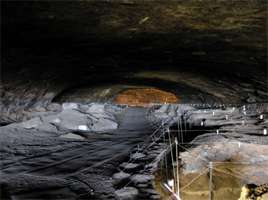
View of the Interior of Wonderwerk Cave. It is a South African National Heritage site due to its role in discovering the human and environmental history of the area
Note the matting put down as a walkway, and the complete and professional job of setting up grid squares to make recording of positions of artefacts quick, accurate and easy.
The cave was discovered when local farmers dug up large parts of the cave in the 1940's to sell the sediments for fertilizer.
Subsequently a series of brief archaeological excavations began. Peter Beaumont of the McGregor Museum carried out major excavations at the site between 1978-1993.
Photo: Royden Yates, Press Release, http://idisk.mac.com/mchazan-Public?view=web
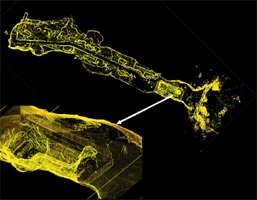
Map of Wonderwerk Cave generated by 3-D scanning carried out by Heinz Ruther of the
Department of Geomatics, University of Cape Town. The inset shows a view of the front
excavation area where the dating project took place.
The cave formed by water action in the Dolomite (a type of limestone rich in magnesium, chemical formula CaMg(CO3)2 , calcium magnesium carbonate) rocks of the Asbestos Hills. This rock formation is over 2 billion years old, some of the oldest rock
on earth, so we do not know when exactly the cave formed. It is 130 metres long.
Photo: Press Release, http://idisk.mac.com/mchazan-Public?view=web
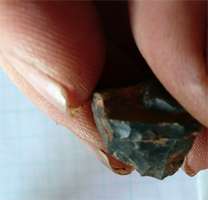
Using a combination of dating methods it has been possible to date the bottom level
reached by Peter Beaumont in the front part of the cave to 2 million years ago. A small number of very small stone tools have been recovered from excavations in this
level.
Geological evidence indicates that these tools were deposited in the cave by human ancestors, not washed into the site from the outside.
The combination of stone tools indicating the presence of human ancestors and the dating of the level leads to the conclusion that human ancestors (hominids) were in the cave 2 million years ago.
This is the earliest evidence for intentional cave occupation by human ancestors. There were a number of species of hominids in southern Africat 2 million years ago. The most likely candidate as the manufacturer of the stone tools found at Wonderwerk is Homo habilis.
The research team was led by Michael Chazan (University of Toronto) and Liora Kolska
Horwitz (Hebrew University) in collaboration with the McGregor Museum.
Photo: M. Chazan, Press Release, http://idisk.mac.com/mchazan-Public?view=web
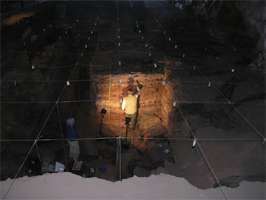
Hagai Ron of the Hebrew University of Jerusalem taking samples.
The oldest known stone tools from sites in Ethiopia date to 2.4 million years. The Wonderwerk Cave discoveries are those close in age to the very earliest known stone tools and similar in date to the bottom levels at Olduvai Gorge.
Photo: M. Chazan, Press Release, http://idisk.mac.com/mchazan-Public?view=web
Two methods were used that together provide a secure date:
Paleomagnetic Dating
Hagai Ron of the Hebrew University took small samples of soil from the entire sequence (over fifty samples). These samples allowed him to measure changes in the earth's magnetic field and to correlate the Wonderwerk sequence with a global timescale for changes in the magnetic field (known as reversals).
Cosmogenic Burial Age
Ari Matmon, also from the Hebrew University, took soil samples and carefully prepared them in the lab. He then sent these samples to an atomic accelerator in the United States where a procedure to measure isotopes, much like the method used in carbon dating, was carried out. Unlike carbon dating, Cosmogenic Burial Age dating can provide very old dates.
Why was this so difficult?
Professor Chazan writes:
Most well dated early sites are in East Africa where there are volcanic ash layers that can be dated using the Argon method. In southern Africa we lack these ash layers so that we need to develop new methods. The first use of Cosmogenic Burial Age dating in South Africa was at the Cradle of Humankind. Our results show the value of this method, particularly when combined with Paleomagnetic dating, for archaeological research both in the region and globally.
References
- Chazan M., 2015: Technological Trends in the Acheulean of Wonderwerk Cave, South Africa, Afr Archaeol Rev, © Springer Science+Business Media New York 2015, DOI 10.1007/s10437-015-9205-8
- phys.org, 2021: Researchers unveil oldest evidence of human activity in African desert cave, https://phys.org/news/2021-04-unveil-oldest-evidence-human-african.html, retrieved 26 April 2021
- Shaar R., Matmon A., Horwitz L., Chazan M., 2021: Magnetostratigraphy and cosmogenic dating of Wonderwerk Cave: New constraints for the chronology of the South African Earlier Stone Age, Quaternary Science Reviews, ( IF 3.803 ) Pub Date : 2021-04-09 , DOI: 10.1016/j.quascirev.2021.106907
- van den Bergh G. et al., 2016: Homo floresiensis-like fossils from the early Middle Pleistocene of Flores, Nature, 534 (7606): 245–248. doi:10.1038/nature17999. PMID 27279221.
